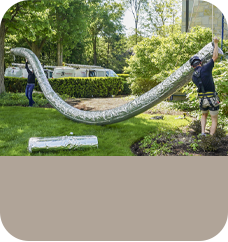Waterproofing
Protect Your Masonry & Prevent Chimney Leaks With Professional Waterproofing Services
If you’ve ever experienced a chimney leak, you know how quickly water can lead to extensive chimney damage and expensive repairs. You also likely know how much of this damage can take place before the leak is detected. That’s one reason why keeping up with annual inspections is so vital. During an inspection, we’ll check all vulnerable areas and look for some of the most common types of moisture-related chimney damage:
 Receding or Cracking Joints
Receding or Cracking Joints
When water enters the mortar holding your chimney’s bricks together, it can cause the joints to erode and crack. As this continues, more and more water gains access to your chimney system and the structural integrity of the chimney is compromised.
Spalling Brick
When water swells and constricts within the brick itself during temperature changes, it can cause the brick to flake and the surface to pop off. This is known as spalling. Spalling brick isn’t just unpleasant to look at – it also detracts from the functionality, safety, and integrity of the entire masonry structure.
Efflorescence
Efflorescence is the term used to describe the whitish salt deposits that appear on the surface of water-damaged brick.
Rusted or Corroded Metal Components
When water makes its way into your masonry chimney, it doesn’t just damage the masonry itself – it also damages the metal components of your chimney system! Commonly, we see rusted and hole-riddled metal chimney liners, dampers, and appliances.
Prevention Is Key
Those of us here at Chimney Solutions have witnessed firsthand the negative effects of water on chimneys, which is why we’re such advocates for masonry waterproofing. When we waterproof chimneys, we use sealants made specifically for chimney masonry. These sealants are different from other waterproofing products, in that they allow vapor to move in and out of the masonry freely. Why is this important? When you light up a fire in your fireplace, vapor is produced and must escape. With traditional waterproofing products, vapor is trapped inside where it can damage the masonry and metal components of the chimney system.







